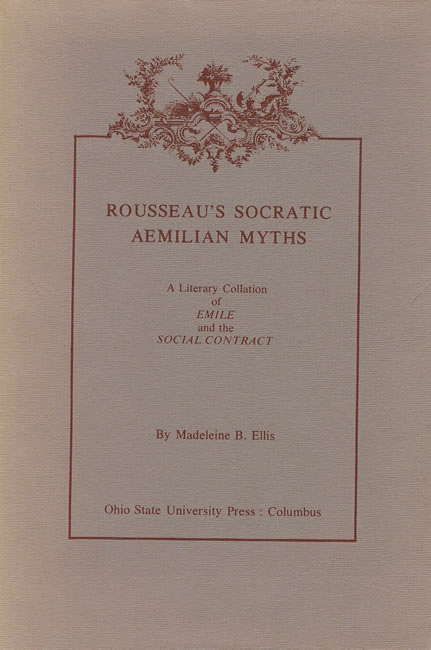Rousseau’s Socratic Aemilian MythsA Literary Collation of “Emile” and the “Social Contract”Madeline B. Ellis |
 1977 LITERARY CRITICISM / European / French 433 pp. 6x9  $34.95 paper 978-0-8142-5319-9 Add paper to shopping cart Shopping Cart Instructions Review/Change Shopping Cart & Check-out |
|||
|
|
In this illuminating study of two literary milestones in the history of our civilization, a noted Rousseau scholar examines for the first time the nature of, and the inspiration for, the symbolic language that informs Rousseau’s two great masterworks. Though Rousseau himself, in the pedagogical novel, invites such a study by including an aesthetic profession of faith and by warning the reader more than once that he is using the language of symbolic expression, Rousseauist criticism has, beyond noting the presence of a few symbols in Emile, produced as yet no systematic inquiry into the emblematic conveyance of ideas therein. Professor Ellis’s scrupulous collation of the texts of the two books and her adroit use of the Old and New Testaments and the Platonic dialogues reveal for the first time that not only is the Social Contract an “appendix” to Emile, as Rousseau says it is, but also that the two together constitute a Rousseauist version of Plato’s Republic and Symposium transfigured by Judeo-Christian and biblical tradition. Although once again Rousseau himself invites such a comparison by calling both Christ and Socrates, or Plato, his “master,” a distinction he accords to no one else, scholars have consistently ignored this invitation as they have the first. Dr. Ellis’s study conclusively demonstrates that the imagery of these ancient writings, which is also Rousseau’s, is the real clue to the relationship between the pedagogical novel and its political appendix. She cites as but one example that, in the Republic, Socrates also tells a “story” about the education of heroes and, moreover, includes a political treatise as well, the two being one and the same treatment of citizenship. Socrates’ objective is Rousseau’s: to portray man’s nature and duties, and to describe the nature of justice and injustice and their effects upon the human soul. To achieve this purpose, he deals with the ideal soul and city together, the soul being the pattern of the perfect city, and employs imagery that Rousseau in turn takes up in both his books, magnifying it in the Contract into an image of the ideal city, or wise order of things. It is in this ideal image of the soul present in both works that it becomes clear that the two productives evolve in obedience to a single and identical plan, the Contract following the novel step by step without once violating the order of the text, and the two moving side by side through the whole of their several parts. Madeleine B. Ellis is professor of French literature and humanities at Marianapolis College, Montreal, and the author of Julie or La Nouvelle Héloïse: A Synthesis of Rousseau’s Thought (1749-1759); Robert Charbonneau et la création romanesque: Une étude de textes; Saint-Denys Garneau: art et réalisme: and Rousseau’s Venetian Story: An Essay upon Art and Truth in “Les Confessions.” | |||

